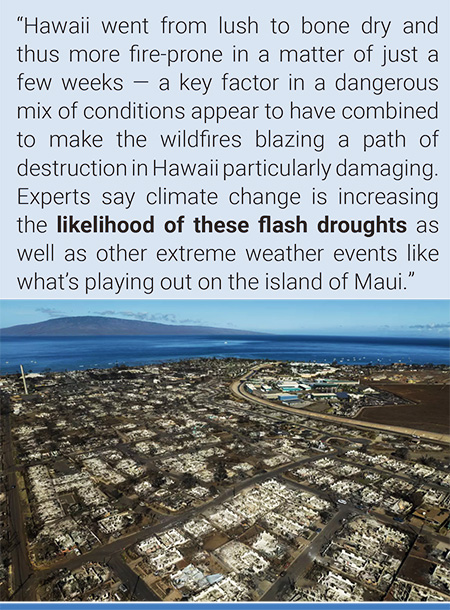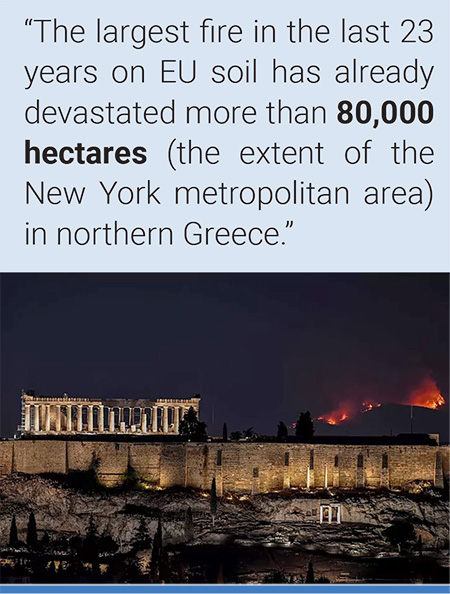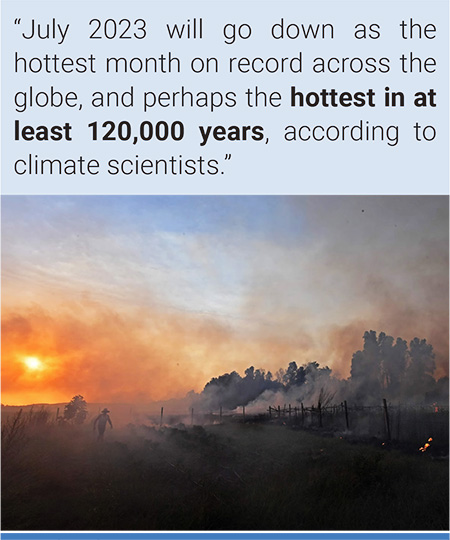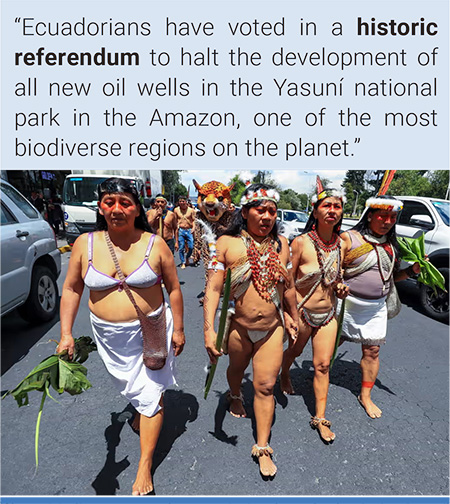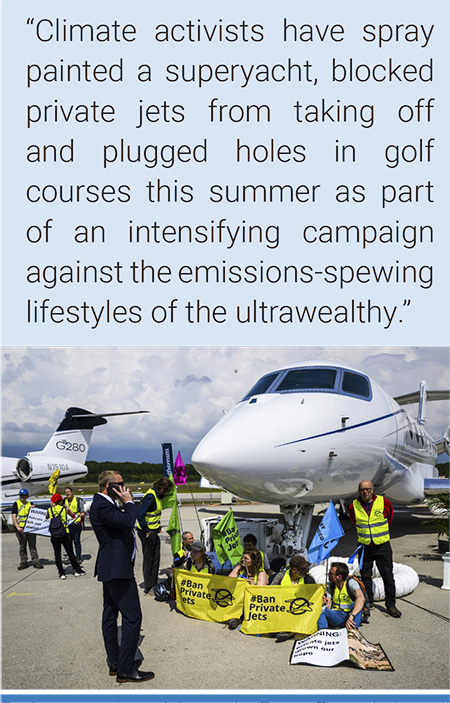Monthly Summaries
Issue 80, August 2023
[DOI]
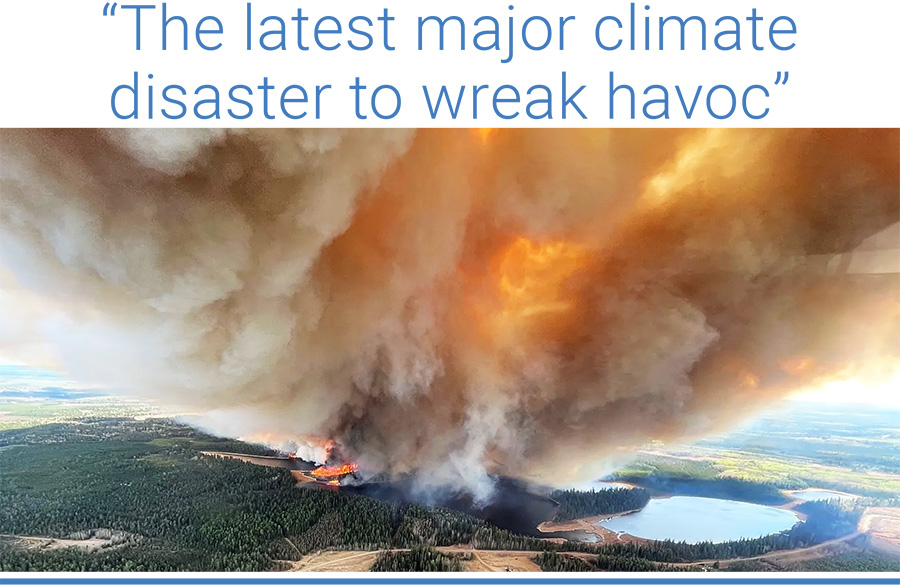
Smoke rises from a wildfire near Lodgepole, Alberta. Photo: Alberta Wildfire via The New York Times.
August media coverage of climate change or global warming in newspapers around the globe dropped 8% from July 2023 and was also 3% lower than August 2022 levels. International wire services went down 11% from July 2023. Compared to the previous month, coverage dipped in Africa (-1%), Asia (-8%), the Middle East (-10%), the European Union (EU) (-15%), and in Latin America (-17%). Meanwhile, coverage increased from the previous month of July in North America (+5%), and in Oceania (+21%). Figure 1 shows trends in newspaper media coverage at the global scale – organized into seven geographical regions around the world – from January 2004 through August 2023.

Figure 1. Newspaper media coverage of climate change or global warming in print sources in seven different regions around the world, from January 2004 through August 2023.
Among countries that we at the Media and Climate Change Observatory (MeCCO) monitor, coverage was up 10% in Canadian print media as well as up 3% in US print.

Figure 2. Newspaper coverage of climate change or global warming in Canadian print sources Globe and Mail, Toronto Star, and National Post from January 2004 through August 2023.
To begin, media coverage in August continued to feature ecological and meteorological dimensions of climate change or global warming news stories. For instance, the beginning of the month saw news of flooding in China, Typhoon Doksuri coming on land in Japan, and a heat wave across South Korea with connections made to climate change. For example, Guardian correspondent Damien Gayle reported, “Ma Jun, the director of the Institute of Public and Environmental Affairs, a Beijing-based NGO, said that while the typhoon had brought the rain, rising ocean temperatures caused by climate change were also contributing to the extreme weather. “China has suffered unprecedented extreme heatwaves since last year … this year, there are record-breaking high temperatures in northern China,” Ma told AFP. “These heatwaves are linked to global warming, and this is what most climate scientists around the world tend to agree.” More is in store for north-east China, forecasters say. Typhoon Khanun, the sixth typhoon of this year, is approaching the country’s eastern coast, after battering Okinawa island, Japan, where it knocked out power to 200,000 homes”.
The devastating Lahaina fire on the Hawaiian island of Maui reduced much of the historic town to ash. Photo: Jae C. Hong/Associated Press. |
Meanwhile, tragic fires on the Hawaiian island of Maui generated considerable media attention as the extent of the devastation – with connections made with a changing climate – was understood. For example, Associated Press correspondents Claire Rush, Seth Borenstein, and Jennifer McDermott reported, “Hawaii went from lush to bone dry and thus more fire-prone in a matter of just a few weeks — a key factor in a dangerous mix of conditions appear to have combined to make the wildfires blazing a path of destruction in Hawaii particularly damaging. Experts say climate change is increasing the likelihood of these flash droughts as well as other extreme weather events like what’s playing out on the island of Maui, where dozens of people have been killed and a historic tourist town was devastated”.
Also, media attention to Canadian wildfires – with connections to climate change – circulated in August. For example, ABC News correspondents Stephanie Ebbs, Julia Jacobo, Daniel Manzo, and Daniel Peck reported, “The historic wildfire season currently plaguing Canada is expected to persist, perhaps becoming even worse in the coming weeks – a potentially devastating forecast made more likely due to human-caused climate change, according to new research. Drought and hot conditions contributed to an unprecedented start to the fire season in Canada and has kept the fires burning all over the country since late April says Kristina Dahl, senior climate scientist at the Union of Concerned Scientists. By June, the smoke emitted from the wildfires reached the highest amount ever recorded in the country… The fire season would not have gotten this bad were it not for anthropogenic, or human-caused, climate change, according to a new study released Tuesday by World Weather Attribution, an international group of academics and officials that evaluate the influence of climate change on extreme weather events”.
Later in August, hurricane activity – particularly Hilary and Idalia – prompted news stories that linked these events with climate change trends. For example, Associated Press correspondents Jordi Lebrija and Damian Dovarganes reported, “Tropical Storm Hilary inundated streets across Mexico’s arid Baja California Peninsula with deadly floodwaters Sunday before moving over Southern California, where it swamped roads and downed trees, as concerns mounted that flash floods could strike in places as far north as Idaho. Forecasters said Hilary was the first tropical storm to hit Southern California in 84 years, bringing floods, mudslides, high winds, power outages and the potential for isolated tornadoes. The storm already dumped more than 6 inches (15.24 centimeters) of rain in some mountain communities and threatened more than an average year’s worth of rain in inland desert areas. Hilary made landfall along the Mexican coast in a sparsely populated area about 150 miles (250 kilometers) south of Ensenada Sunday, then moved through mudslide-prone Tijuana, threatening the improvised homes that cling to hillsides just south of the U.S. border. By Sunday evening, the storm had moved over San Diego and was headed north into inland desert areas. As evening fell in California, the National Weather Service in Los Angeles warned of significant flooding risk throughout populous mountain areas along the coast northeast of Los Angeles… Hilary is just the latest major climate disaster to wreak havoc across the U.S., Canada and Mexico. Hawaii’s island of Maui is still reeling from a blaze that killed over 100 people and ravaged the historic town of Lahaina, making it the deadliest U.S. wildfire in more than a century. Firefighters in Canada are battling that nation’s worst fire season on record”.
As an example of hurricane Idalia reporting – with connections made to climate change – US National Public Radio correspondent Alejandra Borunda explained, “It has been a summer of disasters–and many of them were made worse, or more intense, by human-caused climate change. Wildfires burned from coast to coast across Canada. Vermont was inundated by unprecedented floods. Phoenix's temperatures topped 100 ° F for a full month. And now Hurricane Idalia, the first major hurricane of the season, is ripping across Florida and into the Southeast”. As a second example, Guardian journalists Richard Luscombe and Maya Yang reported, “The storm had rapidly intensified overnight, fueled by the abnormally record hot waters in the Gulf. Studies have shown evidence that Atlantic hurricanes are becoming stronger and intensifying more rapidly due to these accelerants resulting from the climate crisis. More than 280,000 customers in Florida were without electricity, according to poweroutage.us, with a further 50,000 out in Georgia. Kevin Guthrie, Florida’s director of emergency management, said 15 tornado warnings were issued for affected counties”.
A forest burns behind the ancient Parthenon Temple, atop the Acropolis hill, as a wildfire rages on the outskirts of Athens on August 22. Photo: Aris Messinis/AFP. |
In Europe, many news stories covered fires across the continent as they made connections to a changing climate. For example, El Mundo journalist Carlos Fresneda wrote about the biggest fire in the history of Europe: “The largest fire in the last 23 years on EU soil has already devastated more than 80,000 hectares (the extent of the New York metropolitan area) in northern Greece, causing 20 deaths and requiring the assistance of fire departments from other European nations, including Spain. The Greek Government blames the wave on climate change but arrests 163 suspected arsonists since the season began”.
Among news in August looking back on the record-breaking heat across the globe in the month of July, Guardian correspondent Nadeem Badshah reported, “July has been confirmed as the hottest month on record globally after several heatwaves in parts of Europe, according to the Copernicus Climate Change Service (C3S). The global average temperature was 16.95C last month, surpassing the previous record set in 2019 by a substantial 0.33C. Temperatures exceeded 40C last week in several countries across Europe including Greece, France, Italy and Spain. Wildfires forced the evacuation of thousands of residents and tourists from several Greek islands including Rhodes. There were also high temperatures in South American countries, despite it being winter there. July is estimated to have been about 1.5C warmer than the average for 1850-1900, according to C3S, and 0.72C warmer than the 1991-2020 average”. As a second example, CBS News correspondent Emily Mae Czachor noted, “After extreme temperatures scorched vast sections of the planet in July, a worrying climate milestone anticipated by scientists has been corroborated by yet another prominent study. This time, it came from agencies in the U.S., where more than half of the population was subject to heat warnings at one point during the last month…officials at NASA and the National Oceanic and Atmospheric Administration unveiled new data indicating that July was the hottest month on record, with both global sea-surface and land temperatures soaring well above longstanding averages. According to NOAA and NASA, Earth in 2023 saw its warmest July since temperature record-keeping began 174 years ago. Since July is climatologically the hottest month of the year, this year's numbers likely mean it was the hottest month on record overall, NOAA said in a news release. In a separate release issued Tuesday, NASA said scientists at its Goddard Institute for Space Studies in New York determined that "July 2023 was hotter than any other month in the global temperature record." The data came on the heels of a similar report released earlier in August by the Copernicus Climate Change Service, a branch of the European Union's space program. That report also identified July 2023 as Earth's hottest month on record, noting that the global monthly temperature was unusually higher than average. July was so hot that officials at the United Nations announced it would likely break the planet's monthly record before July was even over. Later reports by the European climate agency and now by agencies in the U.S. have reinforced those suspicions”.
Smoke from fires raging in the northwestern Tunisian town of Tabarka covers the sun amidst a blistering heatwave on July 24. Photo: Fethi Belaid/AFP/Getty Images. |
Next, many scientific findings prompted media stories during the month of August. Among them, in early August a report from Nexus Media News that found that 81% of humans endured a warmer July 2023 as a result of human-caused climate change earned media attention. For example, Washington Post journalist Ian Livingston noted, “July 2023 will go down as the hottest month on record across the globe, and perhaps the hottest in at least 120,000 years, according to climate scientists. During this sweltering month for the planet, countless daily, monthly and all-time record high temperatures were reached in multiple regions, often concurrently. A rash of intense heat domes — zones of high pressure sprawled across the northern hemisphere — plagued Asia, southern Europe and northern Africa, North America and much of the tropics including the Caribbean. Extreme heat was even observed on several occasions across the southern hemisphere, where it is the middle of winter. China registered an all-time high temperature for the country of 126 degrees (52.2 degrees Celsius), while the July 16 high of 128 degrees (53.3 Celsius) in Death Valley, Calif., was two degrees shy of the highest reliably measured temperature on Earth. Numerous countries surpassed 122 degrees (50 Celsius) for highs. In the Middle East, the heat index reached 152 degrees (66.7 Celsius), near the limit of human survival… While temperatures are beginning to cool from their annual peaks in much of the northern hemisphere, the unrelenting hot pattern is poised to roll onward. Despite brief pauses in the worst heat in the Southwest United States, warmer-than-normal weather is probable through August in the region, as it is in East Asia and Japan, as well as North Africa and southern Europe”.
Also connecting meteorological and ecological themes with scientific stories, there were further links made between the heat and climate change. For example, Washington Post correspondent Kasha Patel wrote, “This year is increasingly likely to become the hottest year on record, due to a rapidly strengthening El Niño weather pattern and unprecedentedly hot summer. According to climate scientist Zeke Hausfather, 2023 now has an 85 percent chance of becoming the hottest year in the books based on calculations with temperature data from the European Commission’s Copernicus Climate Change Service. Analyses with other temperature data — from the National Oceanic and Atmospheric Administration and NASA, among others — have also shown more than a 50 percent chance that 2023 will be the warmest on record. At the end of June, the nonprofit Berkeley Earth forecast an 81 percent chance of a record 2023”.
Several political and economic-themed media stories about climate change or global warming continued to earn attention in print, screens, and on the airwaves in August. To begin, news of drought – with connections made to climate change – and its impacts on shipping through the Panama Canal was abundant. For example, journalist Joanna Partridge at The Guardian wrote, “Commercial ships are facing long queues and delays to travel through the Panama Canal as a lengthy drought in the Central American country has led to a cut in the number of vessels able to pass through one of the world’s most important trading routes. In a fresh demonstration of the impact of the climate crisis on global business and trade, the Panama Canal Authority (ACP), which manages the waterway, introduced restrictions on the number of transiting vessels as a result of the drought. An extended dry season has reduced the availability of water, required to allow vessels to pass through the canal’s locks, which has triggered a logjam of ships awaiting their turn”.

Figure 3. Examples of newspaper front pages with climate change or global warming-related stories in August 2023.
As August unfolded, many media stories emerged about a ruling in the US state of Montana in favor of youth seeking to protect their climate and environment. For example, CNN journalist Ella Nilson reported, “A Montana judge handed a significant victory on Monday to more than a dozen young plaintiffs in the nation’s first constitutional climate trial, as extreme weather becomes more deadly and scientists warn the climate crisis is eroding our environment and natural resources. In a case that could have legal reverberations for other climate litigation, District Court Judge Kathy Seeley ruled that Montana’s continued development of fossil fuels violates a clause in its state constitution that guarantees its citizens the right to a “clean and healthful environment.” Montana is one of several states that have explicit environmental guarantees written into their state constitutions. While Seeley’s ruling won’t prevent mining or burning fossil fuels in the state, it will reverse a recently passed state law that prohibits state agencies from considering planet-warming pollution when permitting fossil fuel projects. It is also a landmark win for young climate advocates who are turning more to the courts for judgments on the causes and impacts of the climate crisis”.
Waorani indigenous people campaigning for a ‘yes’ vote to stop oil exploration in Yasuní national park. Photograph: José Jácome/EPA. |
Later in August, a successful Ecuadorian referendum that blocks oil drilling in the Chocó Andino rainforest generated many news headlines. For example, Guardian journalist Dan Collyns reported, “Ecuadorians have voted in a historic referendum to halt the development of all new oil wells in the Yasuní national park in the Amazon, one of the most biodiverse regions on the planet. Voters opted to safeguard the unique biosphere by a margin of nearly 20% with more than 90% of the ballot counted – with more than 58% in favour and 41% against, according to Ecuador’s National Electoral Commission. Voting took place in the first round of presidential elections on Sunday. The move will keep about 726m barrels of oil underground in the Yasuní national park, which is also home to the Tagaeri and Taromenane people, two of the world’s last “uncontacted” Indigenous communities living in voluntary isolation. At a time when the climate crisis is intensifying around the world and the Amazon rainforest is fast approaching an irreversible tipping point, Ecuador has become one of the first countries in the world to set limits on resource extraction through a democratic vote. In a second referendum, citizens in Quito also voted to block gold mining in the Chocó Andino, a sensitive highland biosphere near the capital city, by an even larger margin of about 68% to 31%”. As a second example, El País journalists Ana Cristina Basantes and Carolina Mella noted, “After a decade of fighting to save the Yasuní National Park, Ecuador will end oil extraction in this environmental reserve. This was decided by 58.9% of the more than 10.2 million Ecuadorians who have voted in the referendum held this Sunday to stop oil exploitation in block 43 of the ITT (which extends through the areas of Ishpingo, Tiputini and Tambococha). This is a historic consultation, because of what it means for the environmental movement and because it is the first time that a popular initiative consultation has been carried out in this Latin American country. With the victory of the yes, the current oil exploitation is suspended and it will not be possible to sign new contracts for the extraction of this resource”.
Also, US President Joe Biden’s visit to Maui island made news as he drew lines between the tragedy and insufficient climate policy action to date. For example, National Public Radio (US) reporters Asma Khalid, Tamara Keith, and Domenico Montanaro noted, “The president's visit to the state is a fresh reminder of the increasing frequency and severity of extreme weather in the United States — and of his fraught reputation among climate-conscious voters”.
Environmental activists of Stay Grounded and Greenpeace demonstrate while handcuffing themselves to a plane during the European Business Aviation Convention and Exhibition at the Geneve Aeroport. Photo: Laurent Gillieron/Keystone/AP. |
Last, in August many cultural stories relating to climate change or global warming were evident. To illustrate, stories of activism and protest relating to climate advocacy were most pervasive. For example, Guardian correspondent Helen Pidd reported, “Five Greenpeace activists have been arrested after ending their rooftop protest at Rishi Sunak’s North Yorkshire mansion, which they mounted to “drive home the dangerous consequences of a new drilling frenzy”. The campaigners draped the prime minister’s Grade II-listed manor house with an oil-black fabric on Thursday morning. Police said they were managing the situation after being called to the home in Kirby Sigston, near Northallerton, at about 8am after the activists climbed on to roof while Sunak, his wife and daughters were on holiday in California. The group came down at about 1.15pm and were spoken to by officers before being driven away in police vans. The deputy prime minister, Oliver Dowden, left in charge of the country in Sunak’s absence, told the protesters to “stop the stupid stunts”. A former deputy chief constable of North Yorkshire police claimed it was a “major breach of security”, as he called for an “investigation into how this has been allowed to happen”. After reaching the top of the house using ladders and climbing ropes at about 6am, activists unfolded 200 sq metres of fabric to cover a whole side of the property. Two other activists unfurled a banner stating: “Rishi Sunak – Oil Profits or Our Future?” across the grass in front of the house… the prime minister pledged to “max out” the UK’s oil and gas reserves as he announced more than 100 new licences for North Sea drilling, which experts said could be catastrophic for the climate. But in 2021, the International Energy Agency said there could be no new oil, gas and coal developments if the world was to reach net zero by 2050. Greenpeace said the protest aimed to stop Sunak from approving Rosebank, the biggest undeveloped oil and gas field in the North Sea, the operations of which would be enough to exceed the UK’s carbon budgets”.
Elsewhere, Associated Press correspondent David Brunat reported, “Climate activists have spray painted a superyacht, blocked private jets from taking off and plugged holes in golf courses this summer as part of an intensifying campaign against the emissions-spewing lifestyles of the ultrawealthy. Climate activism has intensified in the past few years as the planet warms to dangerous levels, igniting more extreme heat, floods, storms and wildfires around the world. Tactics have been getting more radical, with some protesters gluing themselves to roads, disrupting high-profile sporting events like golf and tennis and even splashing famous pieces of artwork with paint or soup. They’re now turning their attention to the wealthy, after long targeting some of the world’s most profitable companies – oil and gas conglomerates, banks and insurance firms that continue to invest in fossil fuels”.
Thanks for your interest in our Media and Climate Change Observatory (MeCCO) work monitoring media coverage of these intersecting dimensions and themes associated with climate change and global warming.
- report prepared by Max Boykoff, Rogelio Fernández-Reyes, Jennifer Katzung, Ami Nacu-Schmidt and Olivia Pearman

